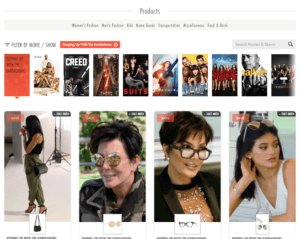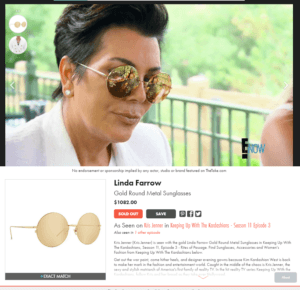The Shazam of Fashion

Want the same pair of sunglasses Kris Jenner was wearing in the latest episode of Keeping Up With The Kardashians? Now you, too, can own them in just a few clicks!
Let’s face it: who enjoys shopping in brick and mortar stores today? From a millennial’s perspective, there are very few occasions left where I would shop in a physical store. Maybe on a Saturday afternoon if I’m trying to kill time I’ll pop into a store or two, but if I’m actually on a mission to buy something, it is almost entirely online. Heck, I even have resorted to buying my groceries online! While some people may attribute this to laziness, this movement to online retailing is infiltrating many younger generations as consumers beg for the convenience and customization that have become table stakes in our new on-demand world.
Digital disruption in retail
According to a 2015 survey by Russel Reynolds Associates of executives, retail is the fourth likeliest industry to be moderately or massively disrupted in the next 12 months.[i]
Source: https://hbr.org/2016/03/the-industries-that-are-being-disrupted-the-most-by-digital
Retail continues to be disrupted in many ways. In the simplest form, there is the disruption of traditional brick and mortar retail by e-commerce, and the proliferation of mobile devices and applications for shopping on-the-go. In fact, by the end of this year, it is predicted that 25% of all retail e-commerce sales will transact via mobile devices.[ii] Even for those consumers who do chose to shop brick and mortar, technology is still there; stores have started using location-based technologies to “provide more personalized, real-time messages, offers and promotions.”[iii]
Further along the spectrum of digital transformation within the industry you will find innovations such as “fit technology,” which leverages technology to help consumers find better-fitting clothing. The technology being implemented varies considerably, ranging from companies like Rent The Runway using community-sourced photos and reviews that include information about the user’s size and body type, to companies such as Acustom Apparel that uses 3D body scanners.[iv]
Needless to say, this only scratches the surface of digital innovations hitting the retail industry by storm.
TheTake
Not only are technology advancements creating many opportunities for existing retailers, but they are also creating space for new retailers to emerge. One such retailer that is capitalizing on one such new technology is TheTake.
Founded in 2013, TheTake allows consumers can “buy almost anything they’ve seen on screen in a feature film, or film trailer.”[v] The website is set up to look like a Pinterest board where shoppers can browse products that were worn, or even find vacation locations where these shows and movie were filmed. Users can filter based on the movie or show and fashion category, and are ultimately directed to the retailer’s website to complete the purchase. Currently the tracking and coding of the featured items is a mix of manual work, audio recognition, and computer vision technology.[vi] As of their launch in 2014, TheTake had approximately 100 movies in its catalog, but has actively been working on expanding this.
Now, you’ll pay the price for keeping up with the Kardashians’ fashion choices – the sunglasses that Kris Jenner was caught wearing in season 11 will cost you $1,082 to own. Thankfully, TheTake also offers suggested, similar products across different price points.[vii]
What’s up next?
As TheTake invests the time and money in building out their tagged movie database, the company becomes a ripe acquisition target for many major retailers – the Nordstrom’s, Bloomingdales, and Saks’ of the world – to enhance their in-store and online shopping experiences. If not through acquisition, how long will it be before these established retailers catch on and start offering their own “Shazam-like” technology?[viii]
The other application I see for this visual recognition technology is for everyday fashion spotting. As a self-proclaimed shopaholic, I frequently see people out in public whose outfits I admire, but don’t have the courage to ask them where they bought it. In a not so distant future, I hope to stealthily snap a picture of this stranger, upload it to TheTake v2.0, and within a few clicks be shopping that stranger’s outfit for myself.
Word count: 663
[i] Harvard Business Review, “The Industries That Are Being Disrupted the Most by Digital,” https://hbr.org/2016/03/the-industries-that-are-being-disrupted-the-most-by-digital, accessed November 2016.
[ii] CIO, “5 cutting-edge retail technology trends,” http://www.cio.com/article/2989716/retail/5-cutting-edge-retail-technology-trends.html, accessed November 2016.
[iii] Ibid.
[iv] Fashionista, “8 Tech Startups Tackling Clothing Fit,” http://fashionista.com/2014/07/8-tech-startups-tackling-clothing-fit, accessed November 2016.
[v] TechCrunch, “TheTake Just Raised $2M So You Can Buy That Thing You Saw In That Movie,” https://techcrunch.com/2014/09/08/thetake-just-raised-2m-so-you-can-buy-that-thing-you-saw-in-that-movie/, accessed November 2016.
[vi] Ibid.
[vii] Wired, “This App Identifies the Movie You’re Watching and Lets You Buy What You See,” https://www.wired.com/2014/12/thetake-app-mobile-shopping/, accessed November 2016.
[viii] Ibid.






This is very interesting business model. I wonder whether they will upgrade the platform to be more Shazam-like? Meaning that consumer can use an app to scan a picture or screen and the app will then suggest which brands and products to purchase. This will enable them to tap into impulse purchase occasions and minimize the time lag between seeing a product to actually doing a research on it. Thanks for sharing!
Interesting business model but I am not sure that it will work for all type of high-end products. An important value proposition of people who shop for high-end product is the ability to interact with the product in stores, in-store services and the opinion of professional fashion sales consultant. While high-end sunglasses could be an easy sell on an online platform I doubt it will work for high end dresses for instance.
As an avid TV watcher and amateur fashion fan, I found your post really interesting. In concept, I love this idea! I love the thought of being able to find more affordable options and as you mentioned, the potential partnerships with retailers is limitless. I do agree though that the digital technology doesn’t seem to have gone far enough in this case. The Shazam-like capabilities that Van described would be optimal here although I’ve always disliked how long it takes to fire up your Shazam and that sometimes means you’ve missed the song. I also wonder how they could better utilize technology to catalog the movies. It seems like that could a quite onerous process and the value of scale is important here. Lastly, I think adding a social media component to this similar to Spotify or Venmo could add value to the consumers’ experience as well.
This is really interesting! It says a lot about how brands should adapt to new consumer habits that call for different shopping experiences. I wonder how the company could be more effective in encouraging consumers to try their app… they could potentially partner with streaming sites such as Netflix, so that after watching a movie TheTake could reach out to you, instead of waiting for customers to proactively browse through their product boards. Recently, Google enabled a feature in Youtube ads (called “shoppable ads”) that allows users to click to shop directly from the ads. This way the user does not have to look at the ad, move to the brand’s website and then conclude the purchase. The less steps for the user to reach the sale, the more effective! Read more about click-to-shop ads here: http://adage.com/article/digital/youtube-adds-click-shop-button-trueview-ads/298702/